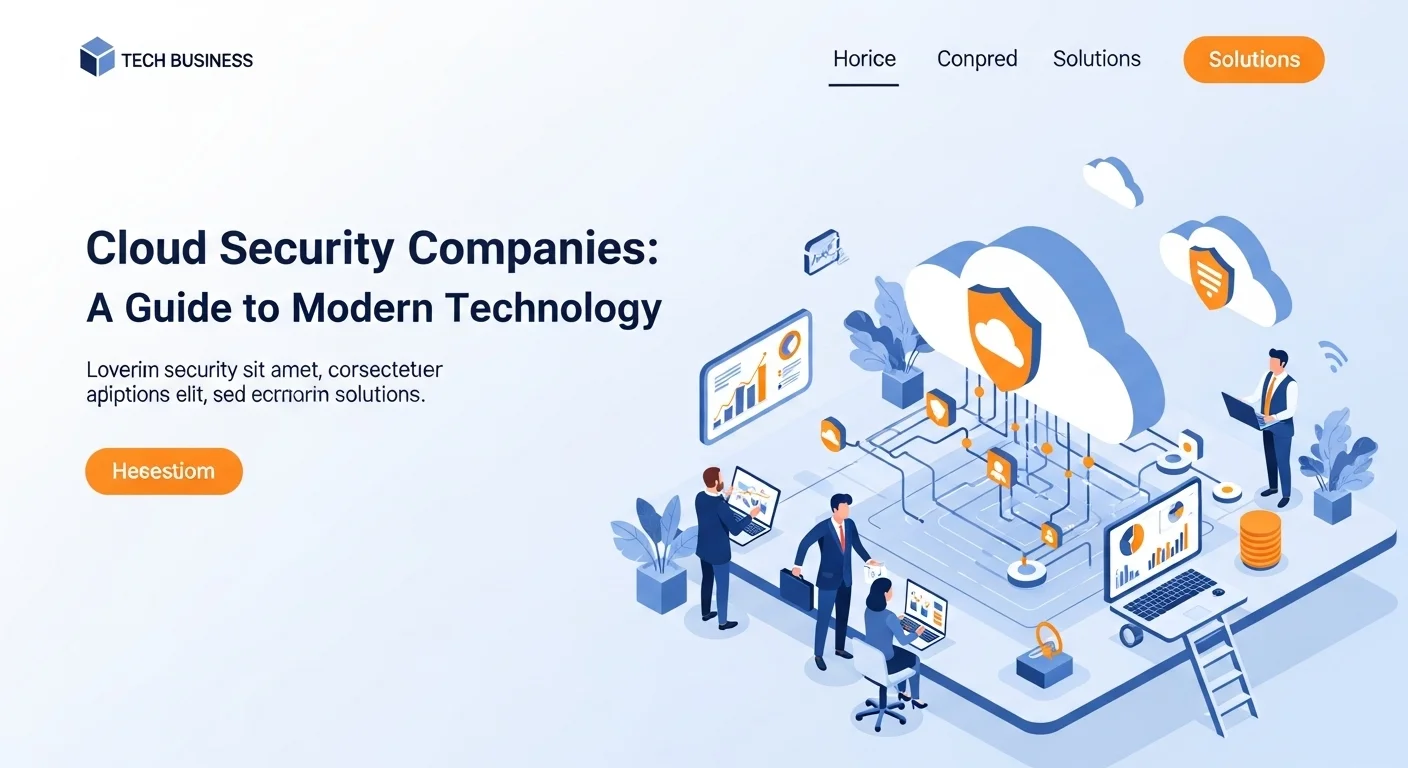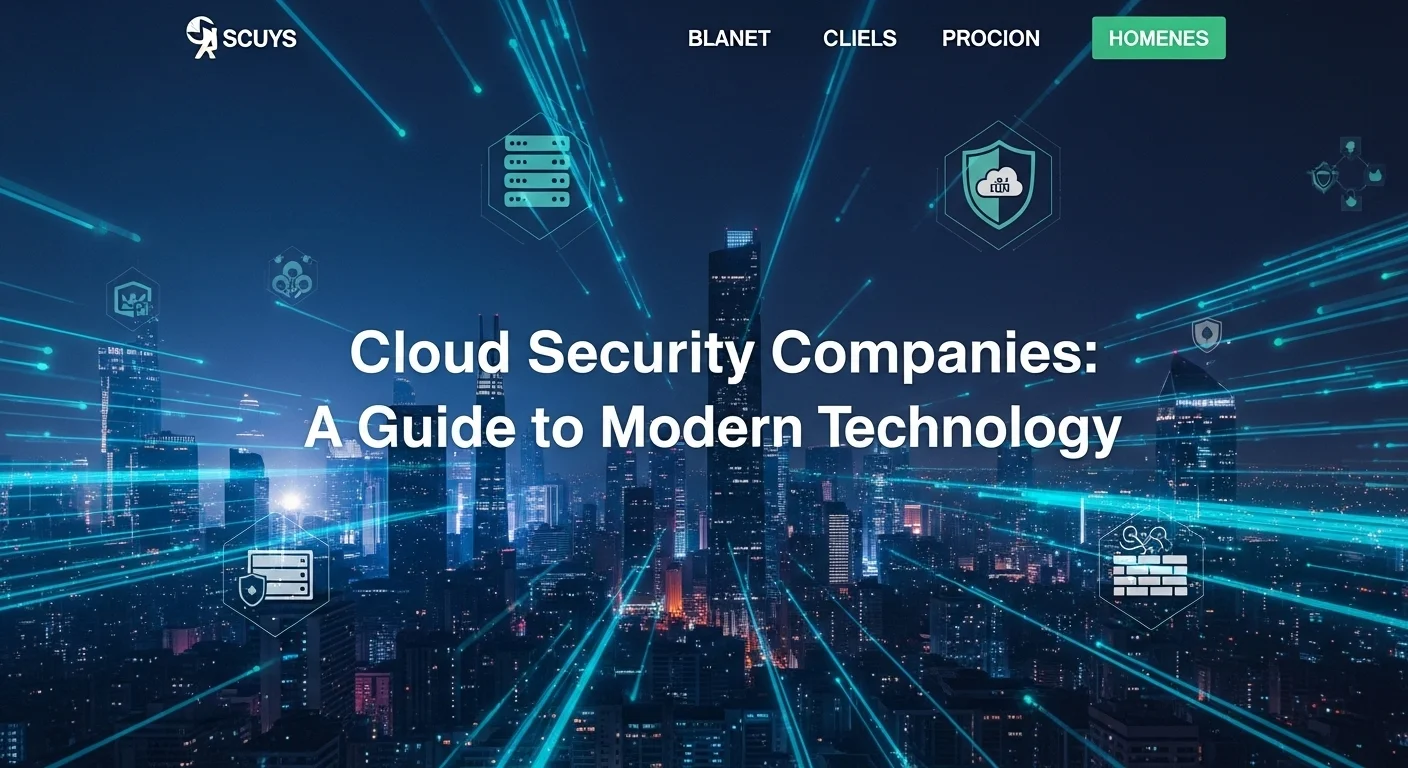Choosing the Right Cloud Security Partner: My Personal Guide for Your Business

Executive Summary
In my years as a security strategist, I've seen countless businesses make the brilliant move to the cloud, only to feel lost in a sea of new security risks and confusing acronyms. It's a tough spot to be in. You know you need to protect your data, but where do you even start? This guide is the conversation I have with my clients to cut through the noise. We'll break down what cloud security really means in simple terms. I'll show you what the best security providers actually do, compare the top players in a way that makes sense for your business, and give you practical, road-tested strategies to build a security posture you can be confident in. Think of this as your personal roadmap to navigating the world of cloud security and finding a partner that truly has your back.
Table of Contents
Table of Contents
- What is Cloud Security, Really? And Why It Matters More Than Ever
- A Complete Guide to Cloud Security Partners and Their Solutions
- Actionable Tips to Improve Your Cloud Security Today
What is Cloud Security, Really? And Why It Matters More Than Ever
Let's be honest, moving your business to the cloud isn't just a trend anymore—it's essential for staying competitive. It gives you incredible power and flexibility. But I've seen many companies make this leap without realizing they've also opened a new, complex door to security risks. This is where specialized cloud security partners become your most important ally. Understanding what they do is the first step to truly protecting your business.
In simple terms, cloud security is everything you do—the rules you set, the tools you use, and the strategies you follow—to keep your cloud-based data, applications, and infrastructure safe from cyberattacks. It's a unique field of cybersecurity because the cloud is so different from a traditional office network. You're not just building a fortress with walls anymore; you're securing a dynamic, interconnected environment that can span multiple providers. The goal is to prevent anyone from getting unauthorized access, stop data breaches before they happen, and ensure your business can continue running smoothly, no matter what threats come your way.
The Shared Responsibility Model: Who's Responsible for What?
One of the first things I clarify with my clients is the 'shared responsibility model'. It’s a core concept, but one that often causes confusion. Think of it like renting an apartment. The cloud provider (like Amazon, Microsoft, or Google) is the landlord. They are responsible for the security *of* the building itself—the physical security, the foundation, the wiring. That's the 'security *of* the cloud'.
You, as the tenant, are responsible for what happens inside your apartment. You're in charge of locking your door, securing your valuables, and deciding who gets a key. This is 'security *in* the cloud'. It includes protecting your own data, managing who has access, and correctly configuring your applications. I can't tell you how many security incidents I've seen happen not because the cloud provider failed, but because this customer side of the bargain was overlooked. The best cloud security firms are experts at helping you manage your responsibilities perfectly.
Why Strong Cloud Security is Non-Negotiable
The importance of getting this right is massive. Your company's most sensitive information—customer details, financial records, secret formulas—is now in the cloud. A single data breach can cost millions in fines and recovery, but the damage to your reputation and customer trust can be even more devastating. I've seen it cripple businesses. A breach can also lead to serious legal trouble if you violate regulations like GDPR or HIPAA, and bring your operations to a screeching halt.
This is why working with expert cloud security providers is so valuable. Here's what they bring to the table:
- Protecting Your Data: Their number one job is to guard your data like it's their own. They use powerful tools like encryption (for data in storage and on the move) and Data Loss Prevention (DLP) to make sure your sensitive info doesn't walk out the door.
- Stopping Threats in Their Tracks: The bad guys are always coming up with new attacks. Top security partners use advanced threat intelligence and AI to spot and stop threats in real time, whether it's malware, ransomware, or a sneaky phishing attempt.
- Keeping You Compliant: Navigating industry regulations is a headache. A good security solution helps you meet standards like ISO 27001 or PCI DSS by giving you the controls, monitoring, and audit trails you need to prove you're compliant.
- Clear Visibility and Control: If you're using multiple cloud services, things can get messy. Security platforms give you a single dashboard to see everything, enforce your security rules everywhere, and simplify management.
- Helping You Move Faster: I've always said that great security doesn't slow you down; it gives you the confidence to speed up. When you know your cloud environment is secure, you can launch new projects, scale up, and innovate without constantly looking over your shoulder.
The Pillars of a Strong Cloud Defense
To build a comprehensive defense, cloud data security experts focus on a few key areas:
- Identity and Access Management (IAM): Think of this as the bouncer for your cloud club. It's all about making sure only the right people get in and they only go where they're allowed. This means using strong Multi-Factor Authentication (MFA)—a must-have that blocks most account takeovers—and giving people the 'least privilege' necessary to do their jobs.
- Infrastructure and Network Security: This is about securing the virtual world your apps live in. It involves things like network segmentation (creating isolated zones to contain a potential breach) and using virtual firewalls. A huge focus here is preventing misconfigurations, which, from my experience, are the leading cause of cloud breaches.
- Data Security: This is about putting your data in a digital vault. It means encrypting data wherever it is and using DLP tools to make sure sensitive information stays put. It starts with classifying your data so you know what's most critical and can protect it accordingly.
- Threat Detection and Response: You have to assume someone might eventually get through your defenses. Continuous monitoring for suspicious activity is key. When a threat is detected, having a well-rehearsed incident response plan means you can act fast to contain the damage.
- Application Security: Security needs to be baked into your applications from day one, not bolted on at the end. This is what 'DevSecOps' is all about. It involves regularly scanning for vulnerabilities and securing APIs, which are common weak points for attackers.
The move to the cloud has changed everything. Your old security playbook won't work here. You need a dedicated, cloud-native strategy, and that's precisely the value that the top cloud security companies provide. They offer the specialized tools and deep expertise to ensure you can harness the full power of the cloud, safely and securely.

A Complete Guide to Cloud Security Partners and Their Solutions
Stepping into the world of cloud security companies can feel like learning a new language, with a whole dictionary of acronyms and competing technologies. Choosing the right partner isn't just a technical decision; it's a critical business move. Let me translate the jargon and give you a practical guide to the solutions and top players out there, so you can make a choice that's right for your organization.
The Core Technologies: Translating the Acronyms
The solutions you'll hear about are built on a few key technologies. Understanding what they do is the first step to finding what you need.
- Cloud Security Posture Management (CSPM): Think of a CSPM as an automated security inspector for your cloud environment. It constantly checks your setup against known best practices and security rules. If it finds a misconfiguration—like a database left open to the internet—it alerts you immediately and can often fix it automatically. In my experience, this is the foundation of good cloud hygiene.
- Cloud Workload Protection Platform (CWPP): While CSPM looks at the environment's configuration, a CWPP focuses on protecting the things running *inside* it—your virtual machines, containers, and applications. It's like having a dedicated bodyguard for each of your workloads, providing services like malware scanning and intrusion detection.
- Cloud Access Security Broker (CASB): A CASB is a security checkpoint that sits between your employees and the cloud services they use (like Microsoft 365 or Dropbox). It enforces your security policies, giving you visibility into what apps are being used, protecting your data, and stopping threats before they reach the application. It's essential for getting a handle on your SaaS applications.
- Cloud-Native Application Protection Platform (CNAPP): This is the new frontier. A CNAPP is an all-in-one platform that combines CSPM, CWPP, and other security functions into a single, integrated solution. The goal is to provide a holistic view of security, from the first line of code to runtime. Many of the best cloud security providers are moving toward a CNAPP model because it simplifies everything and eliminates dangerous blind spots.
- Cloud Identity and Entitlement Management (CIEM): This is a hyper-focused tool that deals with one of the biggest risks in the cloud: excessive permissions. A CIEM analyzes who has access to what and helps you enforce the principle of least privilege, dramatically reducing your attack surface.
A Look at the Top Cloud Security Players
The market has a mix of cybersecurity giants and agile, cloud-native innovators. Here’s my take on some of the leaders:
- Palo Alto Networks (Prisma Cloud): Palo Alto is a titan in this space. I often describe their Prisma Cloud platform as the Swiss Army knife of cloud security—it has a comprehensive tool for almost everything, integrating CSPM, CWPP, and more into a powerful CNAPP. It's a fantastic choice for businesses that want a single, all-in-one solution from a trusted name.
- CrowdStrike (Falcon Cloud Security): Already a leader in endpoint protection, CrowdStrike has brilliantly extended its platform to the cloud. What I love about their approach is the single, lightweight agent that protects both your computers and your cloud workloads. Their biggest strength is the connection to their world-class threat intelligence, making them a top contender for organizations focused on actively hunting down and stopping breaches.
- Zscaler: Zscaler is a pioneer of the 'Zero Trust' architecture, focusing on securely connecting your users to applications, no matter where they are. They are the go-to provider for many of my clients adopting a remote or hybrid work model. Their strength is in securing access and protecting data as it moves across the internet.
- Fortinet: For businesses that have already invested in Fortinet's network security hardware on-premises, extending that protection to the cloud with their 'Security Fabric' is often a natural fit. They offer a broad portfolio and are rapidly enhancing their all-in-one CNAPP capabilities, providing a consistent security policy from your office to the cloud.
- Microsoft (Defender for Cloud): If your organization is heavily invested in the Microsoft ecosystem, using Defender for Cloud is often a no-brainer. It's built directly into Azure and offers powerful protection that also extends to other clouds like AWS and GCP. The seamless integration is its killer feature, making security feel like a natural part of the platform.
- Wiz: Wiz came onto the scene and really shook things up. They championed an 'agentless' approach that my clients love for its simplicity and speed of deployment. It provides incredible visibility across your entire cloud environment, connecting the dots to show you the real attack paths that pose a threat. Their intuitive design has made them a market favorite for a reason.
How to Choose Your Cloud Security Partner
Picking from the many great cloud security companies is a strategic process. Here's the checklist I walk my clients through:
- First, Look in the Mirror: What does your environment actually look like? Are you all-in on one cloud provider or spread across several? Are you mostly using SaaS apps or building your own? Your specific situation will point you toward the right type of solution, be it a CASB, a CNAPP, or something else.
- Demand Great Teamwork: The best security tools play well with others. Look for a partner whose solutions integrate smoothly with your existing tech, like your monitoring tools and development pipelines. An integrated platform approach can save you a lot of headaches and vendor management.
- Agent vs. Agentless: This is a key technical choice. Agent-based solutions (like CrowdStrike) can offer deep, real-time protection but require deployment on each workload. Agentless solutions (like Wiz) are faster to set up and provide broad visibility without touching your live environments. There's no single right answer; it depends on your team's preference and risk tolerance.
- Let the Robots Do the Work: The cloud operates at a scale that humans can't manage manually. Prioritize providers that offer powerful automation for both detecting threats and fixing misconfigurations. This makes you more secure and frees up your team for more strategic work.
- Think About Tomorrow: The cloud is always changing, and so are the threats. Partner with a company that is clearly investing in the future, especially in areas like AI and machine learning for more sophisticated threat detection.
The world of cloud security is fast-moving, but it's filled with incredible technology and brilliant partners. By understanding the core technologies, comparing the strengths of the top cloud security companies, and using a strategic selection process, you can find the perfect partner to secure your journey. Remember, you're not just buying a product; you're building a security program that enables your business to grow with confidence.

Actionable Tips to Improve Your Cloud Security Today
Choosing a great partner from the list of cloud security companies and buying their tool is just the beginning. The real magic happens when you weave security into the very fabric of your technology and culture. To get the most out of your investment, you need a strategy. Here are the practical, road-tested tips I share with my clients to truly enhance their security and make the most of their technology.
Embrace a Zero Trust Mindset
If there's one strategy to adopt for modern security, it's Zero Trust. The philosophy is simple but powerful: 'never trust, always verify.' This means you don't automatically trust any user or device, even if they're inside your network. Every single request for access must be thoroughly checked and verified first. Putting this into practice involves:
- Rock-Solid Identity: Enforce Multi-Factor Authentication (MFA) everywhere, for everyone. I've seen this single step prevent countless attacks. It's one of the most effective defenses against stolen passwords.
- Micro-segmentation: I advise clients to think of their network like a submarine with sealed compartments. By dividing your cloud network into small, isolated segments, you can contain a breach if one area is compromised, preventing attackers from moving freely. The solutions from top cloud security companies make this much easier to implement.
- Least Privilege Access: This is a golden rule. Only give users, apps, and services the absolute minimum level of access they need to do their job. Specialized CIEM tools are fantastic for finding and eliminating the excessive permissions that create unnecessary risk.
Make Security a Team Sport with Automation and DevSecOps
You can't secure the cloud manually; it's just too big and moves too fast. Automation is your best friend. And security can't be an afterthought; it needs to be part of your development process from the very beginning. We call this DevSecOps, and it's about making security a team sport.
- Automate Your Watchtowers: Use your CSPM tool to be your 24/7 guard, constantly scanning for misconfigurations. Better yet, set up automated fixes for common issues. This closes security gaps in minutes, not days, and lets your team focus on bigger problems.
- Secure Your Blueprints: If you build your infrastructure using code (like Terraform or CloudFormation), scan those templates for security flaws *before* you deploy them. This 'shift-left' approach catches problems when they're cheap and easy to fix.
- Build Security into Your Assembly Line: Embed automated security scanning tools directly into your development (CI/CD) pipelines. This way, you're checking for vulnerabilities in your code and its dependencies automatically as you build. Security becomes a seamless quality check, not a final hurdle.
Focus on What Matters Most: Your Data
At the end of the day, security is all about protecting your data. By taking a data-centric approach, you ensure your most valuable assets are safe, no matter where they live.
- Discover and Tag Your Jewels: You can't protect what you don't know you have. Use data discovery and classification tools, often offered by cloud data security companies, to find where your sensitive data is stored across all your cloud services and label it appropriately.
- Encrypt Everything Important: Encrypt all sensitive data, both when it's sitting in storage (at rest) and when it's moving across the network (in transit). Use strong, industry-standard encryption and manage your keys carefully. How you protect your encryption keys is just as important as the encryption itself.
- Deploy a Digital Doorman: Use Data Loss Prevention (DLP) solutions to monitor and block any unauthorized attempts to move sensitive data outside your secure environment. It's like having a doorman who checks everyone's bags on the way out.
The Human Factor: Continuous Learning and Preparation
The best tools in the world can be defeated by a simple human error. That's why building a security-aware culture is so critical.
- Train Your People: Your employees are your first line of defense. Regular security awareness training is essential to teach them how to spot phishing attacks, handle data responsibly, and avoid common traps.
- Practice for a Bad Day: You need a clear, actionable plan for what to do when a breach happens. And you need to practice it. Running drills and tabletop exercises ensures your team can respond quickly and effectively when the pressure is on.
- Stay Informed: The threat landscape is always shifting. I always point my clients to the Cybersecurity and Infrastructure Security Agency (CISA). It's a non-commercial, reliable source for timely alerts and guidance on emerging threats. It's an invaluable resource for staying ahead of the game.
By pairing the incredible technology from the best cloud security companies with sound strategies like Zero Trust and a culture of continuous learning, you can build a truly formidable defense. This isn't a one-and-done task; it's an ongoing commitment. But by taking these steps, you're not just buying a security product; you're building resilience and empowering your business to innovate with confidence in the cloud.
Expert Reviews & Testimonials
Sarah Johnson, Business Owner ⭐⭐⭐
The information on cloud security companies is solid, but I'd love to see more real-world examples for business owners like me.
Mike Chen, IT Consultant ⭐⭐⭐⭐
This is a helpful article on cloud security partners. It clarified a lot for me, though some of the more technical bits could be simplified further.
Emma Davis, Tech Expert ⭐⭐⭐⭐⭐
Excellent article! Very comprehensive on Cloud Security Companies. It helped me a lot for my specialization and I understood everything perfectly.



